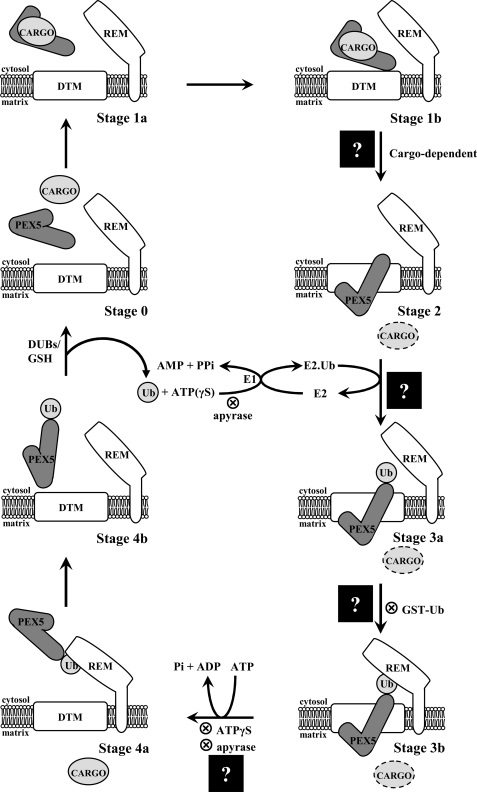FIGURE 1.
The PEX5-mediated peroxisomal protein import pathway. There are five major stages in this protein sorting pathway (numbered 0–4). Substages (a and b) are mostly of conceptual nature. The different stages have been characterized with a PEX5-centered in vitro system, applying several strategies that block (⊗) the pathway at different steps. Stage 0, cytosolic cargo-free PEX5. Stage 1, cytosolic PEX5·cargo protein complex. Stage 2, PEX5 embedded in the peroxisomal DTM. Stage 3, DTM-embedded monoubiquitinated PEX5. Stage 4, cytosolic monoubiquitinated PEX5. Insertion of PEX5 into the DTM is cargo protein-dependent. Monoubiquitination of stage 2 PEX5 yielding stage 3 PEX5 requires activated ubiquitin. Activation of ubiquitin by the ubiquitin-activating enzyme (E1) is an ATP-dependent process; E2 indicates ubiquitin carrier protein. Note that this activation, which involves the synthesis of the acyl phosphate AMP-ubiquitin anhydride and the release of pyrophosphate, can also be achieved with ATPγS (a sulfur atom at a non-bridge position of the γ-phosphate of ATP does not affect the reaction (62)). The ubiquitin analogue GST·Ub is also used efficiently by the ubiquitin-conjugating cascade acting on PEX5. However, this stage 3 species is no longer a substrate for the receptor export module (REM), presumably because of the bulkiness of GST·Ub. Apyrase hydrolyzes ATP and thus blocks PEX5 both at stage 2 and stage 3b levels. Note that if apyrase is added to the in vitro assays before PEX5 (or ΔC1PEX5L), the receptor will not proceed to stage 3a. Stage 4 PEX5 is deubiquitinated, yielding stage 0 PEX5 in a process that probably involves deubiquitinating enzymes (DUBs) and GSH. The step at which cargo proteins are translocated across the peroxisomal membrane (black squares with a question mark) is the topic of this work. Mammalian PEX7 is not represented in the model because it is presently unknown whether it is retained at the DTM together with PEX5L or translocated across the peroxisomal membrane together with the cargo protein, as proposed for the yeast protein (63).

